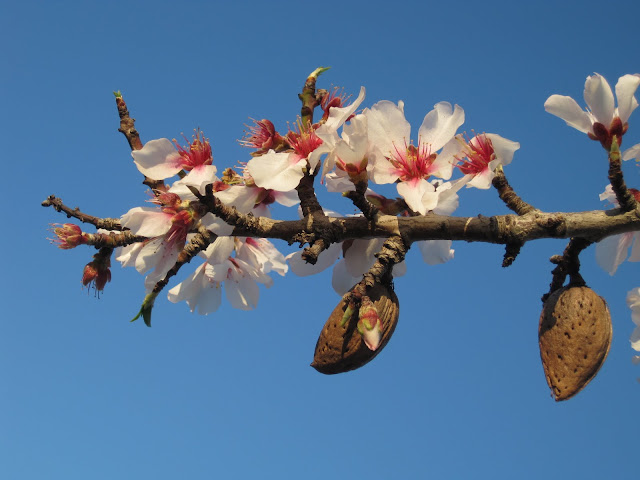 |
| The pink and white blossom of a "bitter almond" tree. |
 |
| White almond blossom in the Ibiza countryside. Traditional hillside terracing can be seen in the background. |
The most famous location for almond blossom is the isolated northern village of Santa Agnes however almond blossom can be seen over much of the rest of the island too. There are two kinds of almond blossom to be seen, the brilliant white of the sweet almond and the pink and white flowers of the bitter almond.
Spain is the world's second largest producer of almonds, accounting for 13% of the global supply and an annual yield of around 220,000 tonnes. Production in Ibiza increased dramatically in the nineteenth Century after traditional olive groves and orange trees were blighted by disease. Almonds were a highly valued commodity and a fundamental source of income to many families as recently as the 1960s. As the traditional ways of life on the island have fallen into the past, almond production has slumped. There is a lot more money to be made by making good preparation for the summer tourist trade than by knocking nuts out of a tree with a stick, de-husking them then sun drying them on large sheets.
 |
| Last years almonds remain on the tree as the new crop flowers and germinates. |
 |
| These days hundreds of tons of almonds end up as rat food. |
The dried almonds could then be sold crude or de-shelled and further processed into products like desiccated, smoked or salted almonds and almond oil.
The staple economic value of the almond crop meant that past generations had to protect their their crop from the many diseases suffered by the trees. A lost harvest could drive families or whole communities into debt.
These days many thousands of trees in Ibiza go completely untouched. On the trees last year's husks rot away from the nut while the tree is bloom. Eventually the nuts themselves fall to the ground to feed the local wildlife lucky enough to posses good nibbling teeth. Rats make large stores of almonds and vast piles of gnawed husks can be found in abandoned buildings across the island. It raises strong emotions in elderly Ibicencos to know that in modern times the almonds they used to treasure have so little value that they now only feed rats.
No comments:
Post a Comment